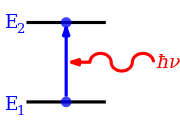Absorption band
In quantum mechanics, an absorption band is a range of wavelengths, frequencies or energies in the electromagnetic spectrum that are characteristic of a particular transition from initial to final state in a substance.
According to quantum mechanics, atoms and molecules can only hold certain defined quantities of energy, or exist in specific states.[1] When such quanta of electromagnetic radiation are emitted or absorbed by an atom or molecule, energy of the radiation changes the state of the atom or molecule from an initial state to a final state.
Overview
When electromagnetic radiation is absorbed by an atom or molecule, the energy of the radiation changes the state of the atom or molecule from an initial state to a final state. The number of states in a specific energy range is discrete for gaseous or diluted systems, with discrete energy levels. Condensed systems, like liquids or solids, have a continuous density of states distribution and often possess continuous energy bands. In order for a substance to change its energy it must do so in a series of "steps" by the absorption of a photon. This absorption process can move a particle, like an electron, from an occupied state to an empty or unoccupied state. It can also move a whole vibrating or rotating system, like a molecule, from one vibrational or rotational state to another or it can create a quasiparticle like a phonon or a plasmon in a solid.
Electromagnetic transitions

When a photon is absorbed, the electromagnetic field of the photon disappears as it initiates a change in the state of the system that absorbs the photon.
The
For some types of bands or spectroscopic disciplines temperature and
Band and line shape

A wide variety of absorption band and line shapes exist, and the analysis of the band or line shape can be used to determine information about the system that causes it. In many cases it is convenient to assume that a narrow spectral line is a Lorentzian or Gaussian, depending respectively on the decay mechanism or temperature effects like Doppler broadening.[3] Analysis of the spectral density and the intensities, width and shape of spectral lines sometimes can yield a lot of information about the observed system like it is done with Mössbauer spectra.
In systems with a very large number of states like macromolecules and large conjugated systems the separate energy levels can't always be distinguished in an absorption spectrum. If the line broadening mechanism is known and the shape of then spectral density is clearly visible in the spectrum, it is possible to get the desired data. Sometimes it is enough to know the lower or upper limits of the band or its position for an analysis.
For condensed matter and solids the shape of absorption bands are often determined by transitions between states in their continuous density of states distributions. For crystals, the electronic band structure determines the density of states. In fluids, glasses and amorphous solids, there is no long range correlation and the dispersion relations are isotropic. For charge-transfer complexes and conjugated systems, the band width is complicated by a variety of factors, compared to condensed matter.[4]
Types
Electronic transitions
Vibrational transitions
Rotational transitions
Rotational transitions take place in the far infrared and microwave regions.[6]
Other transitions
Absorption bands in the radio frequency range are found in
Applications
Materials with broad absorption bands are being applied in
Absorption bands of interest to the atmospheric physicist
In oxygen:
- the Hopfield bands, very strong, between about 67 and 100 nanometres in the ultraviolet (named after John J. Hopfield);
- a diffuse system between 101.9 and 130 nanometres;
- the Schumann–Runge continuum, very strong, between 135 and 176 nanometres;
- the Carl Runge);
- the Herzberg bands between 240 and 260 nanometres (named after Gerhard Herzberg);
- the atmospheric bands between 538 and 771 nanometres in the visible spectrum; including the oxygen δ (~580 nm), γ (~629 nm), B (~688 nm), and A-band (~759-771 nm)[7]
- a system in the infrared at about 1000 nanometres.[8]
In ozone:
- the Hartley bands between 200 and 300 nanometres in the ultraviolet, with a very intense maximum absorption at 255 nanometres (named after Walter Noel Hartley);
- the Huggins bands, weak absorption between 320 and 360 nanometres (named after Sir William Huggins);
- the Chappuis bands (sometimes misspelled "Chappius"), a weak diffuse system between 375 and 650 nanometres in the visible spectrum (named after J. Chappuis); and
- the Oliver R. Wulf).
In nitrogen:
- The Raymond T. Birge, and John J. Hopfield)
See also
References
- ISBN 978-0-470-82831-1.
- ISBN 978-3-031-02387-3.
- ISBN 0471965227.
- ISSN 0021-9584.
- ^ Edgar Bright Wilson, J.C. Decius, Paul C. Cross, MOLECULAR VIBRATIONS. The Theory of Infrared and Raman Vibrational Spectra. McGraw-Hill, New York, 1955
- ^ Harry C. Allen Jr., Paul C. Cross, Molecular Vib-Rotors. THE THEORY AND INTERPRETATION OF HIGH RESOLUTION INFRARED SPECTRA. John Wiley and Sons, Inc. New York, 1963
- ^ David A. Newnham and John Ballard. Visible absorption cross sections and integrated absorption intensities of molecular oxygen (O2 and O4). http://onlinelibrary.wiley.com/doi/10.1029/98JD02799/pdf
- ^ K.M Smith, D.A Newnham. Near-infrared absorption spectroscopy of oxygen and nitrogen gas mixtures. doi:10.1016/S0009-2614(99)00584-9
